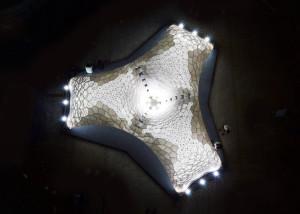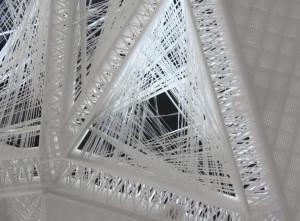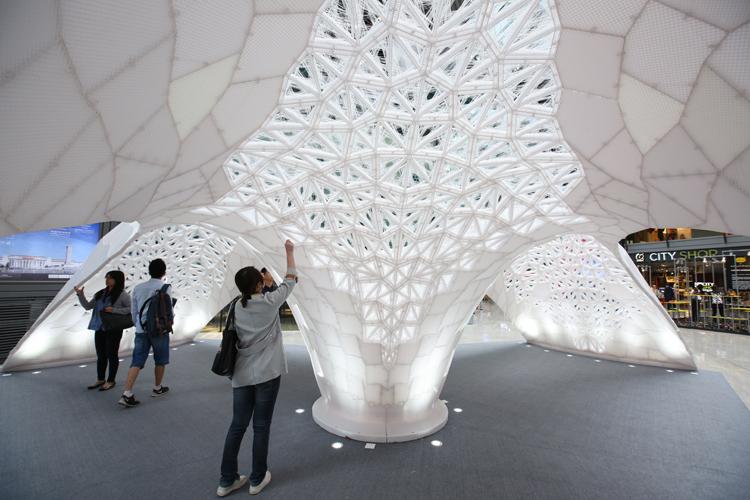 From a distance, it looks as though an alien craft has landed on Beijing. Massive, white, and luminous, the
From a distance, it looks as though an alien craft has landed on Beijing. Massive, white, and luminous, the
mysterious structure is both beautiful and spooky. Come closer, though, and you’ll see that it’s not an alien spaceship – it’s merely the world’s largest 3D printed architectural pavilion. Architects Yu Lei and Xu Feng of Beijing’s Laboratory for Creative Design (LCD) were awarded the Guinness World Record for the structure, which was unveiled as part of Beijing Design Week. The pavilion has been dubbed “Vulcan” due to its resemblance to the mushroom cloud that forms during a volcanic eruption, but it was also inspired by a much smaller facet of nature. Its silken, webbed filaments were drawn from LCD’s research of cocoons.
 Vulcan, which is eight meters long and nearly three meters tall, was formed from 1,086 3D printed constructive units, each of which took thirty days and twenty large-scale 3D printers to create. Once the pieces were printed, an additional twelve days and fifteen people were required to assemble them into the giant structure on the site of Parkview Green, the high-tech commercial and office complex that hosted Design Week. Comprised of three identical modules, the pavilion arched over the complex’s visitors, both a shelter and a sculpture.
Vulcan, which is eight meters long and nearly three meters tall, was formed from 1,086 3D printed constructive units, each of which took thirty days and twenty large-scale 3D printers to create. Once the pieces were printed, an additional twelve days and fifteen people were required to assemble them into the giant structure on the site of Parkview Green, the high-tech commercial and office complex that hosted Design Week. Comprised of three identical modules, the pavilion arched over the complex’s visitors, both a shelter and a sculpture.
“Vulcan represents a new reality – that modern architects are able to achieve their ideal design quality from concept to construction using digital design and fabrication methodologies,” said Lei. “This development will increasingly blur the boundaries between technology and art.”
 The boundaries between technology and art were heavily blurred at Beijing Design Week, which has been an annual event since 2011. Formed as a government initiative to foster design and innovation, the event showcases the latest developments in design fields from architecture to fashion. This year, those developments included a lot of 3D printing; Vulcan was not the only representative of the industry. Chinese luxury fashion company NE-TIGER presented a fashion show called “Body Without Organ,” in which the models wore 3D printed statement accessories that were created using software that digitally maps the movements of the body.
The boundaries between technology and art were heavily blurred at Beijing Design Week, which has been an annual event since 2011. Formed as a government initiative to foster design and innovation, the event showcases the latest developments in design fields from architecture to fashion. This year, those developments included a lot of 3D printing; Vulcan was not the only representative of the industry. Chinese luxury fashion company NE-TIGER presented a fashion show called “Body Without Organ,” in which the models wore 3D printed statement accessories that were created using software that digitally maps the movements of the body.  An interactive 3D printing station called HIVE brought together members of the community to create a structure emphasizing the importance of community collaboration in urban development. Even the children got involved: Little Oasis, a children’s play center at Parkview Green, held a competition to design a climbing structure from recycled materials. The winner will be 3D printed and installed in the center.
An interactive 3D printing station called HIVE brought together members of the community to create a structure emphasizing the importance of community collaboration in urban development. Even the children got involved: Little Oasis, a children’s play center at Parkview Green, held a competition to design a climbing structure from recycled materials. The winner will be 3D printed and installed in the center.
Vulcan, however, was by far the most visible and impressive representative of 3D printing at Beijing Design Week, and exposed yet another facet of the potential 3D printing has to revitalize architecture. Like the silkworm cocoons on which it was based, Vulcan demonstrates that a structure can be delicate and flexible but remarkably strong. Before too long, traditional “brick and mortar” buildings may be a thing of the past.
Subscribe to Our Email Newsletter
Stay up-to-date on all the latest news from the 3D printing industry and receive information and offers from third party vendors.
Print Services
Upload your 3D Models and get them printed quickly and efficiently.
You May Also Like
Heating Up: 3D Systems’ Scott Green Discusses 3D Printing’s Potential in the Data Center Industry
The relentless rise of NVIDIA, the steadily increasing pledges of major private and public investments in national infrastructure projects around the world, and the general cultural obsession with AI have...
3DPOD 260: John Hart on VulcanForms, MIT, Desktop Metal and More
John Hart is a Professor at MIT; he´s also the director of the Laboratory for Manufacturing and Productivity as well as the director of the Center for Advanced Production Technologies....
Etsy Design Rule Change Reduces Selection of 3D Printed Goods
Online marketplace Etsy has implemented a rule change requiring all 3D printed goods on the site to be original designs. The update to the site’s Creativity Standards states, ¨Items produced using...
E-Beam OEM Wayland Additive Partners with USC Racing to 3D Print Titanium Exhaust Collector
Every year, standards organization SAE International holds a competition called Formula SAE, in which students from both undergraduate and graduate programs design, build, and race small formula-style race cars. For...

































